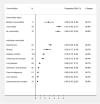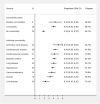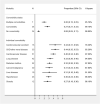A systematic review and meta-analysis of geographic differences in comorbidities and associated severity and mortality among individuals with COVID-19
- PMID: 33879826
- PMCID: PMC8058064
- DOI: 10.1038/s41598-021-88130-w
A systematic review and meta-analysis of geographic differences in comorbidities and associated severity and mortality among individuals with COVID-19
Abstract
Several comorbidities have been shown to be associated with coronavirus disease 2019 (COVID-19) related severity and mortality. However, considerable variation in the prevalence estimates of comorbidities and their effects on COVID-19 morbidity and mortality have been observed in prior studies. This systematic review and meta-analysis aimed to determine geographical, age, and gender related differences in the prevalence of comorbidities and associated severity and mortality rates among COVID-19 patients. We conducted a search using PubMed, Scopus, and EMBASE to include all COVID-19 studies published between January 1st, 2020 to July 24th, 2020 reporting comorbidities with severity or mortality. We included studies reporting the confirmed diagnosis of COVID-19 on human patients that also provided information on comorbidities or disease outcomes. We used DerSimonian and Laird random effects method for calculating estimates. Of 120 studies with 125,446 patients, the most prevalent comorbidity was hypertension (32%), obesity (25%), diabetes (18%), and cardiovascular disease (16%) while chronic kidney or other renal diseases (51%, 44%), cerebrovascular accident (43%, 44%), and cardiovascular disease (44%, 40%) patients had more COVID-19 severity and mortality respectively. Considerable variation in the prevalence of comorbidities and associated disease severity and mortality in different geographic regions was observed. The highest mortality was observed in studies with Latin American and European patients with any medical condition, mostly older adults (≥ 65 years), and predominantly male patients. Although the US studies observed the highest prevalence of comorbidities in COVID-19 patients, the severity of COVID-19 among each comorbid condition was highest in Asian studies whereas the mortality was highest in the European and Latin American countries. Risk stratification and effective control strategies for the COVID-19 should be done according to comorbidities, age, and gender differences specific to geographical location.
Conflict of interest statement
The authors declare no competing interests.
Figures




References
-
- KA, Y. & GR, T. Coronavirus disease 2019 (COVID-19): management in hospitalized adults. In: UpToDate (ed Post, T. W.) (UpToDate, 2021). https://www.uptodate.com/contents/covid-19-clinical-features.
Publication types
MeSH terms
LinkOut - more resources
Full Text Sources
Other Literature Sources
Medical

